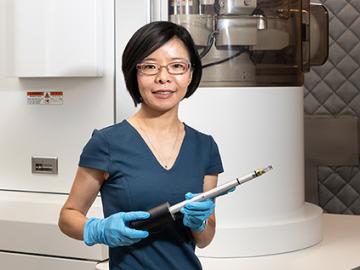
Filter News
Area of Research
- (-) Materials (143)
- Advanced Manufacturing (17)
- Biological Systems (4)
- Biology and Environment (50)
- Building Technologies (8)
- Chemical and Engineering Materials (1)
- Clean Energy (198)
- Climate and Environmental Systems (4)
- Computational Biology (1)
- Computational Engineering (3)
- Computer Science (12)
- Electricity and Smart Grid (2)
- Energy Sciences (4)
- Fossil Energy (1)
- Functional Materials for Energy (2)
- Fusion and Fission (17)
- Fusion Energy (8)
- Isotope Development and Production (1)
- Isotopes (10)
- Materials Characterization (2)
- Materials for Computing (14)
- Materials Under Extremes (1)
- Mathematics (1)
- National Security (16)
- Neutron Data Analysis and Visualization (2)
- Neutron Science (47)
- Nuclear Science and Technology (26)
- Nuclear Systems Modeling, Simulation and Validation (2)
- Quantum information Science (4)
- Renewable Energy (2)
- Sensors and Controls (2)
- Supercomputing (61)
- Transportation Systems (4)
News Type
News Topics
- 3-D Printing/Advanced Manufacturing (12)
- Advanced Reactors (3)
- Artificial Intelligence (3)
- Bioenergy (5)
- Biology (2)
- Biomedical (2)
- Buildings (2)
- Chemical Sciences (11)
- Clean Water (1)
- Climate Change (3)
- Composites (5)
- Computer Science (5)
- Coronavirus (1)
- Critical Materials (6)
- Cybersecurity (2)
- Decarbonization (2)
- Energy Storage (16)
- Environment (5)
- Frontier (2)
- Fusion (4)
- Grid (1)
- High-Performance Computing (2)
- Irradiation (1)
- Isotopes (4)
- ITER (1)
- Machine Learning (2)
- Materials (35)
- Materials Science (31)
- Microscopy (14)
- Molten Salt (2)
- Nanotechnology (17)
- National Security (1)
- Neutron Science (8)
- Nuclear Energy (5)
- Partnerships (2)
- Physics (7)
- Polymers (8)
- Quantum Computing (2)
- Quantum Science (2)
- Simulation (1)
- Space Exploration (1)
- Sustainable Energy (6)
- Transformational Challenge Reactor (1)
- Transportation (9)
Media Contacts

Researchers have pioneered a new technique using pressure to manipulate magnetism in thin film materials used to enhance performance in electronic devices.

Scientists have discovered a way to alter heat transport in thermoelectric materials, a finding that may ultimately improve energy efficiency as the materials

Miaofang Chi, a researcher at the Department of Energy’s Oak Ridge National Laboratory, has received the 2019 Kurt Heinrich Award from the Microanalysis Society (MAS).

OAK RIDGE, Tenn., May 1, 2019 – Sheng Dai, a researcher at the Department of Energy’s Oak Ridge National Laboratory, has been elected fellow of the Materials Research Society (MRS).

OAK RIDGE, Tenn., March 22, 2019 – Karren Leslie More, a researcher at the Department of Energy’s Oak Ridge National Laboratory, has been elected fellow of the Microscopy Society of America (MSA) professional organization.

Researchers used neutron scattering at Oak Ridge National Laboratory’s Spallation Neutron Source to investigate the effectiveness of a novel crystallization method to capture carbon dioxide directly from the air.

Scientists have tested a novel heat-shielding graphite foam, originally created at Oak Ridge National Laboratory, at Germany’s Wendelstein 7-X stellarator with promising results for use in plasma-facing components of fusion reactors.

Oak Ridge National Laboratory scientists analyzed more than 50 years of data showing puzzlingly inconsistent trends about corrosion of structural alloys in molten salts and found one factor mattered most—salt purity.

Oak Ridge National Laboratory scientists studying fuel cells as a potential alternative to internal combustion engines used sophisticated electron microscopy to investigate the benefits of replacing high-cost platinum with a lower cost, carbon-nitrogen-manganese-based catalyst.



